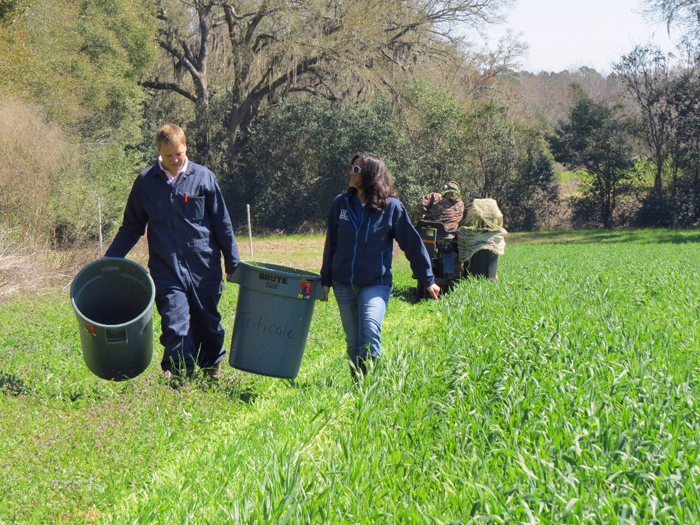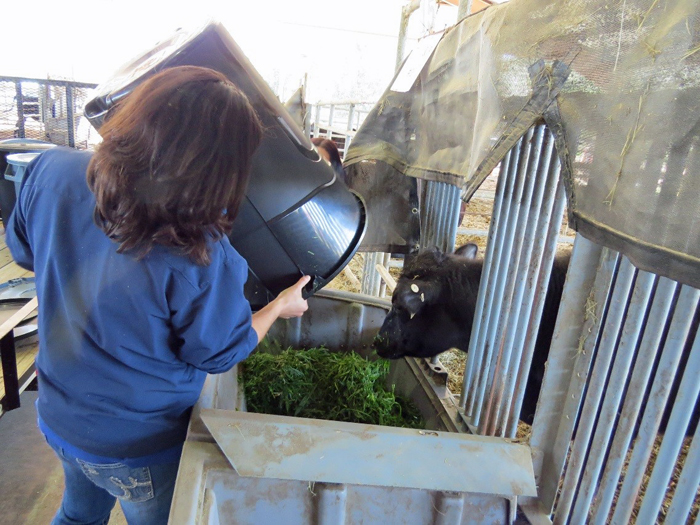Nicolas DiLorenzo, State Beef Specialist, University of Florida NFREC
You often hear from university cattle specialists, extension agents, nutritionists, your neighbor, and anyone else you may ask about winter supplementation, that planning ahead is one of the keys for success. By making sure we know how much feed resources we will need (hay bales, stockpiled acres, commodity feed) we can certainly avoid paying high prices in the middle of the winter when we run out of feed. I know you may be thinking that you’ve heard this before and this is simply common sense… however, before you quit reading and move to the next article of Panhandle Ag e-news, I need to let you know that this article is about one of the not-so-easy-to-calculate amounts of feed needed: winter annual forages.
Most of the hay intake studies in the literature target cool season forages or legumes with greater protein contents than our typical southeast grasses used for hay. A few studies conducted at North Florida Research and Education Center (NFREC) with growing heifers, lactating cows and weaned cows in which intake of hay was measured, have provided some useful information. Those studies can be summarized as follows: when feeding ad libitum (free choice) amounts of Tifton 85 bermudagrass hay, lactating beef cows can consume 1.7% of their body weight (BW), while dry cows and growing heifers can consume 1.4% of their BW daily. This contrasts with reported intake estimates of around 2% of BW/d for fresh cool season grasses or legumes. The main difference in intakes between these forage types are due to the variation in digestibility. The equation is simple: the more forage that remains undigested in the gut, the less room for more forage intake and, consequently, decreased weight gains.
Believe it or not, if we go to the other extreme (i.e., fresh winter forages with excellent protein and TDN content), we can experience a similar phenomenon. The gut fill may limit the amount of dry matter (DM) consumed in a day. However, the big difference is that the nutrient concentration is much greater in winter annuals than in hay from warm season forages, and thus, a small amount of DM consumed is sufficient to generate weight gains that can exceed the 2 lb/d. The concentration of dry matter (DM) in hay is not an issue. The gut fill occurs because of accumulation of slowly digested hay in the rumen. For winter annuals on the other hand, the concentration of DM is an issue. The gut fill occurs because of excess water in the forage, even when the little DM present in it is highly digestible.
Accurately measuring forage intake (whether warm season or winter annuals) remains as one of our greatest challenges. If we can calculate the amount of winter grazing to be consumed in one day, we can have an idea of the amount of pasture area needed for the herd, which goes back to my initial comment in the article: the key for a successful winter feeding program is to plan ahead. The problem is that we do not have an easy way to measure intake under grazing conditions. Also it is not as simple as it appears: other variables need to be considered such as regrowth rate of the pasture, management, herbage allowance, rainfall, temperature, etc.

Taking advantage of technology present at the University of Florida Feed Efficiency Facility (UF-FEF) at NFREC, we designed an experiment aimed at, among other objectives, measuring the amount of winter annual forage potentially consumed by cattle under grazing. For two consecutive years, we fed greenchopped winter annual pastures comprised of: 1) rye + ryegrass; 2) triticale + ryegrass or 3) oat + ryegrass to growing beef cattle housed at the UF-FEF. Figures 1 and 2 show the procedures followed. Needless to say this was a very labor intensive enterprise, with daily chopping of forage and transport from the pasture to the UF-FEF, thus we restricted the data collection each year to a total of 28 days: 14 days of adaptation and 14 days of intake and other measurements. The results were as follows: regardless of winter forage type, cattle consumed on average 9% of their BW daily in pounds of forage as is (fresh). With an average of 16% DM in the cool season forages tested, this translated to 1.44% of BW in a DM basis.
Surprisingly, this is the same amount of hay DM that a growing heifer consumed in one of our previous experiments at NFREC. The difference is that while the growing heifers gained 0.4 lb/d on bermudagrass hay, with the same amount of DM/lb of BW, the growing cattle fed winter forages gained 2 lb/d. Surprisingly, the 9% of BW (fresh forage) was quite consistent across years and forages, providing an easy rule of thumb to calculate how much fresh forage could be expected to be consumed daily, regardless of cattle body weight.

Take Home Message
Gut fill can limit intake in cattle consuming lower quality hay or lush, high quality forages, although with much different outcomes in terms of performance. While water intake creates a gut fill effect in lush pastures, undigested forage can do the same in cattle fed dry hay. Cattle consuming hay free choice or grazing a winter pasture may eat the same amount of dry matter daily, regardless of the amount of forage offered, but on hay may only gain 0.4 lb/d (hay) while grazing winter forages may gain 2 lb/d or more. If we need to make a quick calculation of the amount of fresh, lush forage to be consumed under grazing, using 9% of the body weight per day provides a close estimate that you can use for making calculations.
 0
0
